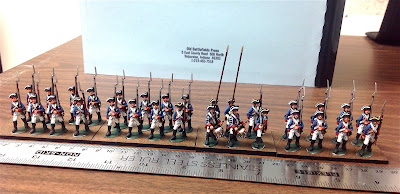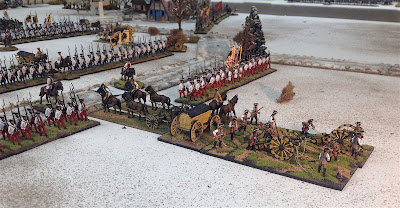 |
| Refighting History - Volumes 2 and 3 (click picture to enlarge) |
I received copies of Volumes 2 and 3 of Charles S. Grant's new wargaming series: "Refighting History" as Christmas presents this year and I have had many enjoyable hours reading and rereading both books.
Volume 1 in the series covered Fighting Withdrawals in the Seven Years War and included several small actions at Asch, Hoyerswarda and Pretsch, all occuring in 1759. The opening shots in the book are packed with lots of eye candy: picture after picture of Grant's wargame armies and an overview of the philosophy behind The War Game rules. The book concludes with an in depth analysis of Prussian Horse Artillery and the addition of horse artillery rules to Grant's evolving rules, The War Game (which have been modified so extensively that they should no longer be considered as "old school" rules).
The next two volumes cover some of the important battles of the War of Austrian Succession that were fought in the Prussian-Austrian theatre of war.
Volume 2
Volume 2 includes the battles of Mollwitz, Chotusitz and a small action at Sahay. The book begins with an overview of Grant's armies and organizations of the Vereinigte Freie Stadt (which look similar to the Prussian army) and the Grand Duchy of Lorraine (which looks suspiciously like the French army). There are lots of color pictures of figures from Minden Miniatures and Crann Tara Miniatures that look lovely and are pleasing to the eye.
Grant next gets down to business and opens with the famous battle of Mollwitz, which is a Grant family classic as shown in the original book The War Game. Charles presents the original Mollwitz game fought by his father (Charles Grant senior) followed by some helpful historical material on Mollwitz and how he boiled the forces down into playable wargame armies for table top action. Then follows a modern version of the game in which the Austrian cavalry arm plays a major role in winning the battle of Mollwitz (oh the horror!).
Grant then offers a rather novel scenario for Mollwitz that features only the cavalry action of the two armies, which he calls "A Slice of Mollwitz". Again the Austrian cavalry prevailed in this scenario, and in spite of that (considering my Prussian bias) it looks like a fun scenario. After all, how many times do we get to fight a cavalry-only battle on the table top. The battle report is chock full of colorful pictures of the action.
Next up is the battle of Chotusiz, considered Frederick "first victory" (Marshall Schwerin should get the credit for the historical victory at Mollwitz). This is a battle that I've rarely seen gamed and is a scenario that I would like to try on my own in the near future. Following the same format as Mollwitz, the Chotositz battle begins with an historical overview followed by the methodology of translating the armies into smaller, more playable wargame forces, and then the actual wargame report, again with lots of color pictures of Minden Miniatures. Alas, the Austrians win again, doh! The game report also includes a number of specially drawn maps of the game at various stages of the battle, which make it easier to follow the course of the wargame. Grant allows the two army commanders to give a summary of their battle plans and pregame strategy is I find to be an interesting twist to the usual wargame after action report.
The third and final battle in Volume 2 is an action fought at Sahay fought on May 24, 1742 between the French and the Austrians. The battle was fought some 65 miles from Prague, in Bohemia. It was actually a fighting withdrawal of the Austrian army (10,000 men) in the face of a superior force of French (18-20,000). Sahay is not a very well documented battle in the history books so this part of the book reveals some new information about the WAS, as far as I'm concerned, so this is a useful book to have if you have an interest in the WAS.
The refight of the battle results in a rather Pyhric Victory for the French army. I like this sort of game scenario as there is an imbalance between the two armies, with the objective of the smaller army being to extricate itself from the battle rather than fighting for a victory.
Volume 2 ends with a look at the historical maneuvering of forces and how to adapt this to table top warfare. Charles shows you a picture of what an actual squadron of cavalry and a battalion of infantry would look like at a 1:1 scale. Interesting stuff and much to ponder. He also illustrates what a 10-gun artillery battery would look like including all of its logistical support elements.
Volume 3
The next volume in the series covers the Silesian battles of Hohenfriedburg and Soor, both of which were Prussian victories historically and also Prussian victories on the table top (huzzah, at last!). It concludes with the battle of Rocoux which was fought in modern day Belgium between the French and the Pragmatic Army.The book begins with more pictures of Charles S. Grant's modern wargame armies, which I'm pleased to see are largely Minden and Crann Tara figures, both ranges being sculpted by the talented Richard Ansell.
Next up is the Battle of Hohenfriedburg fought on June 3, 1745. This battle featured the famous charge of the Prussian Bayreuth Dragoons (who put 20 Austrian battalions to flight, captured 67 colours, 2,500 prisoners and 5 guns. Grant breaks the battle down into two war-game scenarios: the initial attack of the Prussians on the Austrian left wing held by the Saxon army and then the central action between the Austrians and Prussians. The battle retelling follows the same format as discussed in Volume 2, so I won't rehash the details of that. Both battle scenarios end up as Prussian victories, but both could have gone either way so the scenarios are very balanced, as far as I'm concerned.
The next battle is the Battle of Soor fought September 30, 1745 between the Austrians and Prussians. It ended as a Prussian victory and basically ended the War of Austrian Succession as the Austrians concluded that they could not defeat Frederick in battle. Soor is presented in the usual format with an historical overview, a construction of the war-game armies, and a presentation of the battle scenario fought between two players. Soor is another one of those battles that rarely gets attention in the history books or on the table top, so it is a scenario that I look forward to fighting. Soor is broken down into three different scenarios: the Prussian assault on the Graner Kop, the battle in the center, and finally, a small action in which Austrian light forces conduct a raid on the Prussian encampment. I think that readers will find the raid scenario a fun one to play - lots of color pictures enhance this scenario.
The last of the three battles is Rocoux, fought near Liege on October 11, 1746 between Marshal de Saxe's French army and Ligonier's Pragmatic Army of Dutch, British, Hanoverian and Austrian forces. The French have numerical superiority and launch a bludgeon style attack on the Allied positions. The French take quite a pounding, but in the end, the weight of numbers favors the French and results in a victory, both historically and on the table top.
Conclusion
This review is longer than normal, but I have to say that I thoroughly enjoyed both volumes 2 and 3 and give it my highest recommendation if you are an enthusiast of 18 Century warfare. The combiniation of historical overviews, construction of the scenario armies, and the actual battle report complete with the thoughts of the two commanders, make these "must have books" for your collection.




























































